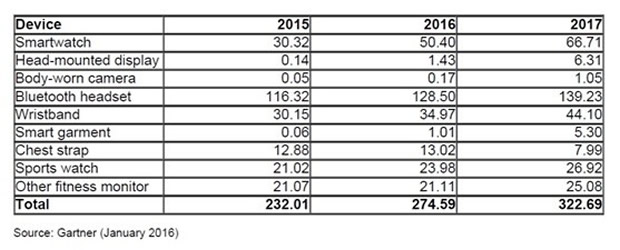Design of wearable devices: Make versus buy
In the PC age, the computers we used mostly were found on our desk tops. Now, the computers we use the most are carried, as smartphones. Soon there will be a proliferation of devices worn moving beyond today's Bluetooth headsets, fitness wristbands, chest straps and smart watches, to other forms and functions, including embedding electronics in our clothes.
Gartner forecasts 74.6 million wearable devices will be sold this year, up 18.4% on 2015, generating revenue of $28.7tn. So there's a solid opportunity here for companies with a good idea, the right design and the ability to bring it to market quickly.

Wearable device volumes worldwide, millions of units
What will it take to have the right design? The first requirement is to have the right features, colour, such as to appropriate user interface for the application, the right sensors to capture raw data, right analytics to draw insights from the data, and the right ecosystem to bind the device and the analysis together into a satisfying user experience.
Understanding how a wearable will be used will influence its size and it’s likely therefore battery capacity, which will affect how long it can run between charge cycles.
System architects therefore will need to decide whether their wearable's firmware should stand to be updateable over the air, which will influence the choice of host processor and memory capacity.
Wearables, by definition, go where their wearers go, so they also will need to protect the design from rain, dust, and wide temperature variations. And then there are the ergonomics, producing a wearable did is uncomfortable to wear is a sure path to market rejection.
Connectivity is important, and the choice of WiFi , Bluetooth, ZigBee, cellular or other Approaches, will involve making a trade-off between the volume of data to be transferred, how often it has to be uploaded, and the distance it has to be sent. Some wearables may use a low-energy solution; such as Bluetooth low energy, to pass small amounts of data to a smartphone acting as a gateway to a cloud-based analytics service. Others such as location monitors will need a cellular connection.
System architects will need to trade off the potential benefits of developing their own connectivity solutions with the time, uncertainty and related loss of market opportunities of doing that.
Designing, testing and qualifying a cellular interface for use anywhere in the world is not straightforward. RF design takes specialist skills, test equipment and facilities. Having to spend weeks reworking a PCB due to EMI issues can more than cancel out the cost benefits of a discrete design.
There's usually a difference between the price on the bill of materials and the cost to the project of your design choices, and learning this lesson can be painful.
It is not as if packaged solutions are inelegant. Our SARA-U2 modules are offered in a 16x23x3mm LGA and weighs less than 3g. It offers high-speed 5.76Mbit/s (HSUPA) and 7.2Mbit/s HSDPA cellular data rates, with at idle current draw down to 0.9mA.
Many wearables so will need to track their location. The most obvious way to do this is using a Global Navigation Satellite System (GNSS) receiver. Again, system architects need to decide whether to make or buy a solution, although modules: such as our EVA M8M embody so many generations of product optimisation those who did decide to make their own face a high bar. The module is packaged in a 7x7x1mm LGA, weighs 0:13g, and Consumes up to 25mA in continuous Operation and as little as 5.5mA in a power-saving mode in Which GNSS data is updated once a second.
GNSS system can be augmented in places where it is hard for the receiver to pick up satellite signals, colour: such as dense urban areas or indoors, using a positioning system based on the location of cellular base stations. U-blox Cell Locate can provide a coarse estimate of a device's location, based on previous observations from other Cell Locate-enabled modules.

Cell Locate mobile network positioning technology
Power management is an important part of a wearable design, as system architects shoulder stand so look for connectivity and GNSS modules did manage their energy consumption effectively, without affecting the wearable's responsiveness to user input.
The wearables sector offers rich opportunities for product and service innovation. If system architects have a clear idea of their product's key differentiating value it will help them decide where to focus their team's talents for greatest impact, and where to take advantage of existing solutions to get their wearable to market more quickly and at lower risk.
By Paul Gough, Principal Corporate Strategy, u-blox.
Courtesy of u-blox.











